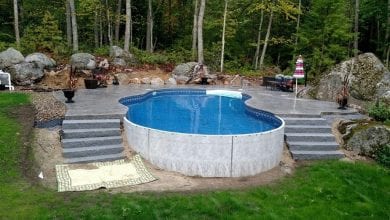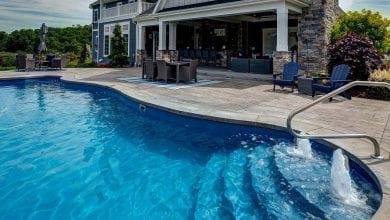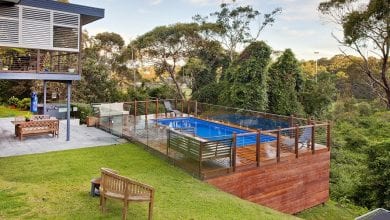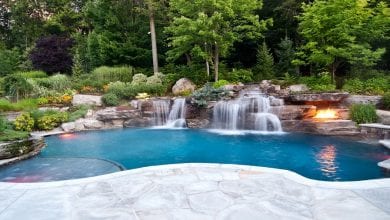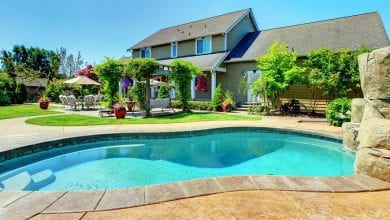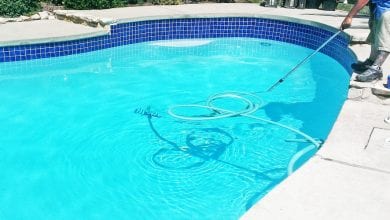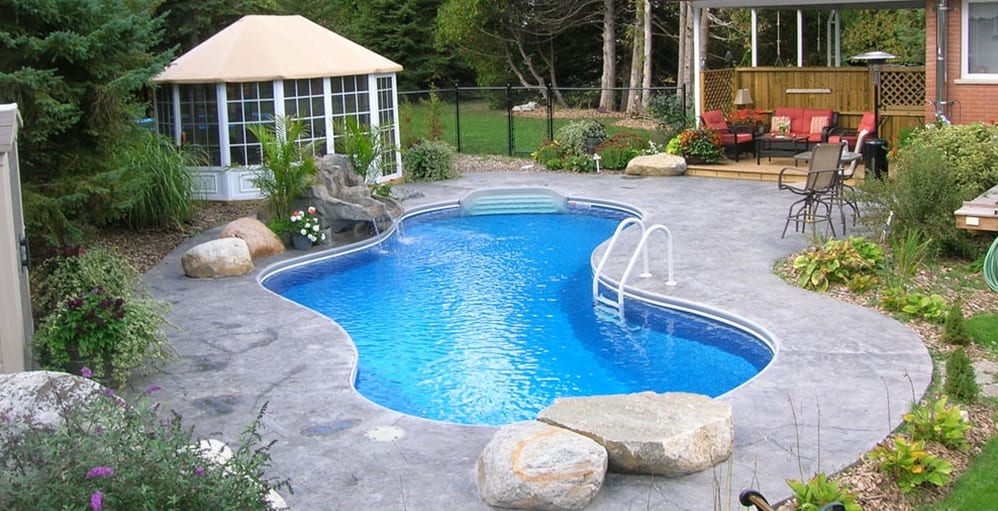
How To Clear A Cloudy Pool With Baking Soda
Even though most pool owners concentrate on keeping their pool sanitized with chlorine or some other pool sanitizer, not every pool owner thinks about their pool’s balance of alkalinity and acidity. And that’s unfortunate because this balance is just as important as adding chlorine to a pool. It’s also the reason why adding baking soda to a pool is absolutely important to maintaining clear pool water.
It’s important for pool owners to realize that their pool’s chemical balance is extremely sensitive and requires the pool owner to make adjustments to it from time to time. Sometimes that means adding chlorine to kill off and sometimes that means adding baking soda to add a bit of alkalinity to the pool.
Baking soda, also known as sodium bicarbonate, is a natural alkaline that has a pH level of 8. When it’s added to pool water in the proper amount, it will raise both the pH level and the alkalinity of the pool. This will improve the stability of the pool’s chemical profile and result in better pool clarity. Although there are dozens of different pool clarifying products available, most of them are based on baking soda. That’s why we often advise our readers to just go straight to the source and purchase baking soda for their pool. They will save money in the long run and still achieve the same results.
Now we understand that some people might be reading this article and wondering how they can clear a cloudy pool with baking soda. After all, that is the title of this guide. And yes, we’re here to say that you can clear the cloudiness out of your pool and we’re going to show you how. Before we do, however, let’s find out what causes pH levels in the pool to go out of whack and how that can cause cloudiness.
What Causes a pH Imbalance & Cloudy Pool Water?
Improper pH levels in the pool’s chemicals are caused by seven main issues. They’re caused by improper chlorine levels, unbalanced pH and alkalinity, a faulty or clogged filter, ammonia buildup, debris buildup, and high calcium hardness levels. Two of these problems are actually related to one another: improper chlorine levels and unbalanced pH and alkaline levels. And we’re going to discuss why this is the case next.
One of the reasons for falling alkalinity is when the pool owner uses too much chlorine in their pool. When this occurs, it not only lowers the pH level of the pool but also its alkalinity. As alkalinity falls, it becomes increasingly more difficult to keep the pH level of the pool stable.
And this effect can stack on each other as the pool owner tries to add other chemicals to the pool. And this can cause a condition called pH bounce. This is a rapid and cyclic change in pH levels between an acid and a base. This can be a difficult problem for the pool owner to correct.
How Will Baking Soda Help My Pool?
Baking soda is naturally alkaline so it can combat pH issues when used properly. It will raise both the pH and the alkalinity of the pool, and it will do it in a safe and natural way. Of course, as is the case with anything you add to your pool, you’re still going to have to add it in a measured manner, but that isn’t too difficult for most people to accomplish.
How To Use Baking Soda To Correct Cloudy Pool Water
Unfortunately, one of the biggest misconceptions about baking soda is that it alone will solve cloudy pool water and that’s simply not the case. It’s part of a regimen that can be used to correct cloudy pool water, but it won’t do it by itself. As we go into further detail, you’ll understand what we mean.
Before you can deal with pool cloudiness, you’re first going to have to find out the cause for the cloudiness. One of the first culprits you should check is the pool’s pump and filter. Is the pump working correctly and is the filter clogged or malfunctioning in any way? If you find out those issues aren’t the problem, then it’s time to take a look at the chemical composition of your pool.
You’re going to want to bring out your pool testing kit and check the pool water’s hardness. If the water is already naturally hard, then you’re going to want to discontinue the use of any product that adds additional calcium to the pool. You’re also going to want to make sure that alkaline levels are higher than 80 parts-per-million, but are less than 110 PPM.
Most cases of cloudy pool water should be solved by super chlorinating the pool. This is usually what will solve the problem the quickest. However, once that’s done, you’re going to have to test the pool water and make sure that the pH levels are between 7.2 and 7.8. If the pH level is below 7.2 and the total alkalinity is below 80 ppm, then you’re going to need to add baking soda.
Once you’ve done that, you will need to figure out how much baking soda is needed to sufficiently raise the total alkalinity level of the pool. Approximately 1.25-pounds will raise the total alkalinity of the pool by 10 PPM. Just calculate how much baking soda is needed to correct the total alkalinity of the pool. However, it should be stated here that no more than 2.5 pounds of baking soda should be added to the pool in a single day.
The baking soda can be used in the skimmer or sprinkled on the surface. No matter how it’s distributed through the pool’s water, it’s important to note that it will probably take anywhere from 5-10 hours for the baking soda to distribute. After that period of time has elapsed, retest the water and see if the additional measures are required.
Using Baking Soda For Other Pool Problems
Since we’ve already addressed how to use baking soda to clear cloudy pool water, we thought that we’d stick around and address other problems in the pool that baking soda can be used to treat. What, you didn’t know that baking soda can be used for more than just clearing up cloudy water? Well, it can and we’re going to talk about some of the more common uses for baking soda in and around the pool.
Clearing Up Algae In The Water
Algae come in many different forms. There’s blue algae, green algae, and even yellow algae. These different algae forms not only cloud and dull the water in a pool, but they can also create a nasty and slippery pool surface. And no one wants to have to deal with this slimy substance. Fortunately, it can be treated by keeping pH levels between 7.2 and 7.8, all while keeping alkalinity between 100-110 PPM.
Treating Pool Corrosion
If the pipes or ladders in your pool are beginning to corrode, or the pool liner is beginning to pit, then your pool is likely suffering from low water alkalinity. The water should be tested and then baking soda added to raise the total alkalinity of the water.
Spot Treating Algae On Surfaces
If you have algae stains on your surfaces, then you’re going to need more than baking soda. You’re also going to need an algaecide as well. Fortunately, there are plenty of algae killing products, so you can pretty much choose the one you want.
After you have secured it, apply the algae killer to the pool according to the manufacturer’s directions. Give the algaecide time to circulate around the pool. This can take anywhere from 6 to 10 hours. When the algae killing product has been given enough time to work, sprinkle baking soda directly on the problem area. Using a pool-safe scrub brush, scrub the affected area with baking soda. It should come off quickly and easily.
Sometimes Baking Soda Isn’t The Right Product For The Job
Although we’ve gone through using baking soda for clearing up cloudy water, for dealing with algae, and for other uses, we would like to take a moment and remind our readers that baking soda isn’t a product that doesn’t solve all problems. In fact, there are some instances that you would probably be better off using a different product. Let’s explore one such scenario, so that you can clearly see the instances in which you would use some other product.
Let us give you an example. Let’s say that you have to adjust the pH level of a 10,000-gallon pool from 6.8 to 7.2 to get it up to the minimum pH level that the water is supposed to be in. If you used baking soda for that purpose, it would take over 20-pounds of baking soda. And that would increase the alkalinity of the water—perhaps to a level above 150 parts-per-million. As we stated earlier, that is outside the 80 to 120 PPM that’s required for a healthy pool.
So how would a pool owner solve the problem of raising their pH level high enough to keep it in a healthy range and do it without blowing the total alkalinity levels too high? Well, one solution is to use soda ash. To raise the pH level of a pool from 6.8 to 7.2 would only take about 12.2 ounces of soda ash in a 10,000-gallon pool. And that small amount of soda ash will only raise the total alkalinity by only 10ppm or less.
Sometimes Water Cloudiness Isn’t The Cause Of Cloudy Water
As we stated earlier, total alkalinity isn’t the only cause of pool cloudiness and there are issues that can’t be solved with baking soda. Below is a quick recap of the other causes of pool cloudiness that can’t be treated simply by using baking soda—although, in some instances, baking soda can help balance alkalinity levels after prescribed treatment.
Improper Chlorine & pH Levels
Like we said earlier, this is often the culprit when it comes to cloudy water. When the pH level is too high, calcium won’t dissolve properly and will give the pool’s water a cloudy look. If the pH is too low, chlorine becomes overly reactive and depletes very quickly. This fast chlorine depletion forms chloramine and this is not only ineffective in killing algae and bacteria but also turns the water cloudy.
Cyanuric Acid Imbalances
Imbalanced stabilizers such as Cyanuric Acid, also known as CYA, could also cause cloudiness. This usually happens when CYA isn’t properly balanced with free chlorine levels. Bacteria will convert the Cyanuric Acid into ammonia and this can cause pool water cloudiness.
Calcium Hardness Levels That Are Too High
It’s also worth mentioning that people who live in areas with hard water might have problems with high calcium hardness. This happens when calcium can dissolve properly in the water, so it just kind of floats there. In some cases, the calcium hardness level is so high the pool owner will have to drain the pool to correct it. To avoid this from arising, make sure that Calcium Hardness levels in the pool are no higher than 400 ppm and no lower than 200 ppm.

